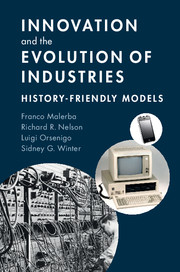Book contents
- Frontmatter
- Contents
- List of figures
- List of tables
- Preface and acknowledgments
- Codes
- Some remarks about notation
- 1 Innovation and industrial evolution
- 2 History-friendly models: methods and fundamentals
- 3 The US computer industry and the dynamics of concentration
- 4 Vertical integration and dis-integration in the computer industry
- 5 The pharmaceutical industry and the role of demand
- 6 Reprise and conclusions
- References
- Author index
- Subject index
4 - Vertical integration and dis-integration in the computer industry
Published online by Cambridge University Press: 05 August 2016
- Frontmatter
- Contents
- List of figures
- List of tables
- Preface and acknowledgments
- Codes
- Some remarks about notation
- 1 Innovation and industrial evolution
- 2 History-friendly models: methods and fundamentals
- 3 The US computer industry and the dynamics of concentration
- 4 Vertical integration and dis-integration in the computer industry
- 5 The pharmaceutical industry and the role of demand
- 6 Reprise and conclusions
- References
- Author index
- Subject index
Summary
INTRODUCTION
The remarkable increases in computational power and reductions in the costs of computation that have been achieved over the history of the computer industry have been made possible largely by advances in semiconductor technology. At the industry's inception, and more recently, the semiconductors used in computers were designed and produced almost exclusively by independent semiconductor firms. But at times during the industry's history, at least the largest computer firms were vertically integrated and designed and produced the semiconductors they used. This chapter concerns this history of vertical integration and then dis-integration, and the factors shaping that history.
In the following section we describe the history of vertical integration and dis-integration of large computer firms, which we are interested in explaining. Then we consider various theories of vertical integration and lay out the one that seems to provide the best fit to the historical case. Briefly, we build on the “competence-based” approach, and argue that the vertical scope of computer producers was largely determined by the co-evolution across firms of specific capabilities for designing and producing semiconductors, and by the size and nature of markets for semiconductors and computers. Thus, our interpretation departs significantly from standard theories based on transaction costs, and incomplete contracts. Then we develop our history-friendly model, guided by the history and the theory we regard as most persuasive, and present both history-friendly and counter-history runs. We pull the strands together in our concluding section.
THE HISTORY TO BE EXPLAINED
This chapter analyzes the choices computer firms make: of designing and producing semiconductor inputs themselves or buying them from outside vendors. As in Chapter 3, we concentrate on the US computer industry, and we use the same time period we addressed in Chapter 3 to analyze concentration in the industry. As we described there, this period saw a shift in the basic electronic components used in computers from vacuum tubes to transistors, to integrated circuits and then to microprocessors, the advent of which enabled the development of the personal computers (PCs). Our focus will be on the standard electronic components. The large computer companies have always designed and produced customized components in-house; the key decision they faced was whether to make or buy their more standardized components.
- Type
- Chapter
- Information
- Innovation and the Evolution of IndustriesHistory-Friendly Models, pp. 93 - 149Publisher: Cambridge University PressPrint publication year: 2016

